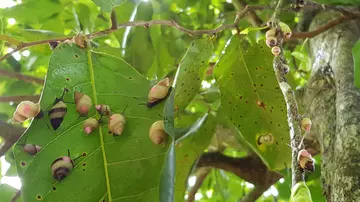
ZSL
Zoological Society of London
25 years in the making
Two Extinct-in-the-Wild species of tropical snail have been returned to their native homeland for the first time in French Polynesia, 25 years after they were wiped out by a human-introduced invasive species.
International conservation charity ZSL worked with other leading zoos and the French Polynesian Government to coordinate a conservation breeding programme – involving the progeny of the last individuals found in the Society Islands in the 1990s.
This year, the reintroduction focused on two species, Partula rosea and Partula varia, with several thousand being carefully transported over 15,000km from Chester Zoo and Whipsnade Zoo in the UK to the French Polynesian Islands.
Part of the world’s largest reintroduction programme, with a total of 14 different snail species and sub-species being reintroduced over the last five years – Huahine and Moorea in the Society Islands are now 4,159 snails stronger this year, thanks to further successful reintroductions over the past few weeks.
ZSL coordinates the global collaboration between 16 zoos and conservation organisations which has seen 15,000 individuals make the journey back to the Islands since its inception. A total of 10 species and sub-species of Partula were also released again this year, with snails coming from Artis Zoo in Amsterdam, Edinburgh Zoo in Scotland and London Zoo in England.

Paul Pearce Kelly, Senior Curator of Ectotherms at ZSL explained: “In addition to their ecological and cultural importance, Partula snails are a family of species incredibly valuable to the scientific community, having been studied for more than a century due to their isolated habitat providing the perfect conditions to study evolution – they’re a bit like the Darwin’s finches of the snail world.
“Due to the valuable information gathered from the studies, conservationists were alerted to the fact that an invasive species was decimating populations, allowing the zoo community to pull together a global action plan for the species.
“This reintroduction programme is, without a doubt, helping to bring the species back the brink of extinction and shows what can be achieved when the international conservation community works together.”
How did the Partula Snail become extinct in the wild?
Most of the Society Islands’ endemic snails were wiped out in the 1980s and early 1990s, after the invasive predatory rosy wolf snail (Euglandina rosea) was introduced to rid the islands of a previously introduced alien species, the African giant land snail (Lissachatina fulica). Unfortunately, the predatory rosy wolf snail targeted the endemic snails instead, and across the region – many species were lost or close to extinction shortly after the predator’s arrival.
The last few surviving individuals of some of the species were rescued by a team led by ZSL London Zoo’s Head of Invertebrates, Dave Clarke in September 1994 in order to begin the international conservation breeding programme. Others were already being studied at universities around the world, and it was these individuals that formed the source group to begin breeding to re-populate the Islands.
Christophe Brocherieux, Project Manager at the French Polynesia Government Environment Department said: “We’re extremely pleased with the progress of the Partula reintroduction programme. So many of the species faced a deadly concoction of threats – but with a dedicated and motivated team, those threats have now thankfully been controlled.”

Partula snails and the community
Partula rosea and varia also have a very strong cultural affinity with the people of Huahine, who traditionally used the shells for making crowns and necklaces for special occasions. Returning the snails to the island is therefore as much a cultural as a conservation celebration.
Dr Gerardo Garcia, Curator of Lower Vertebrates and Invertebrates at Chester Zoo, said: “Breeding and nurturing more than 2,000 snails requires years of dedication – so to see these animals released into their historic homeland was a very emotional moment.
“Crucially, this also marks the return of a connection between the species and local community. The snail’s place at the heart of the nation’s culture and tradition is crucial to their survival. On the island of Huahine, future generations will live side by side with the species once again. Together with valley communities there, we can safeguard a brighter future for snails.
“Worldwide, our planet’s rich biodiversity is under threat. Every single one of those tiny animals now represents a special symbol of hope.”
LEARN MORE ABOUT THE PARTULA SNAIL PROJECT
The Partula snail reintroduction programme was partially supported by the Mohamed bin Zayed Species Conservation Fund, of which much of the fieldwork would not be possible without.
